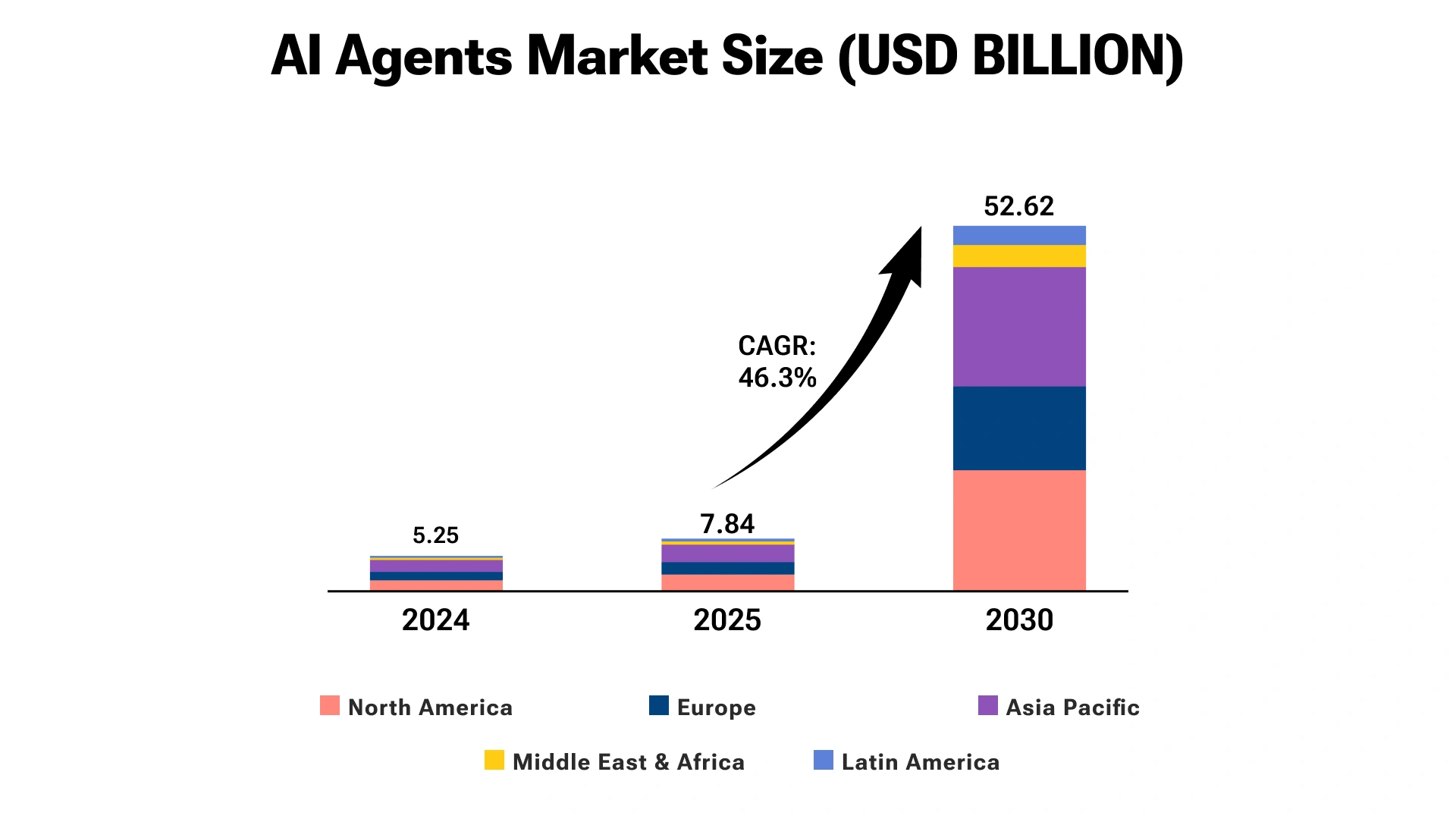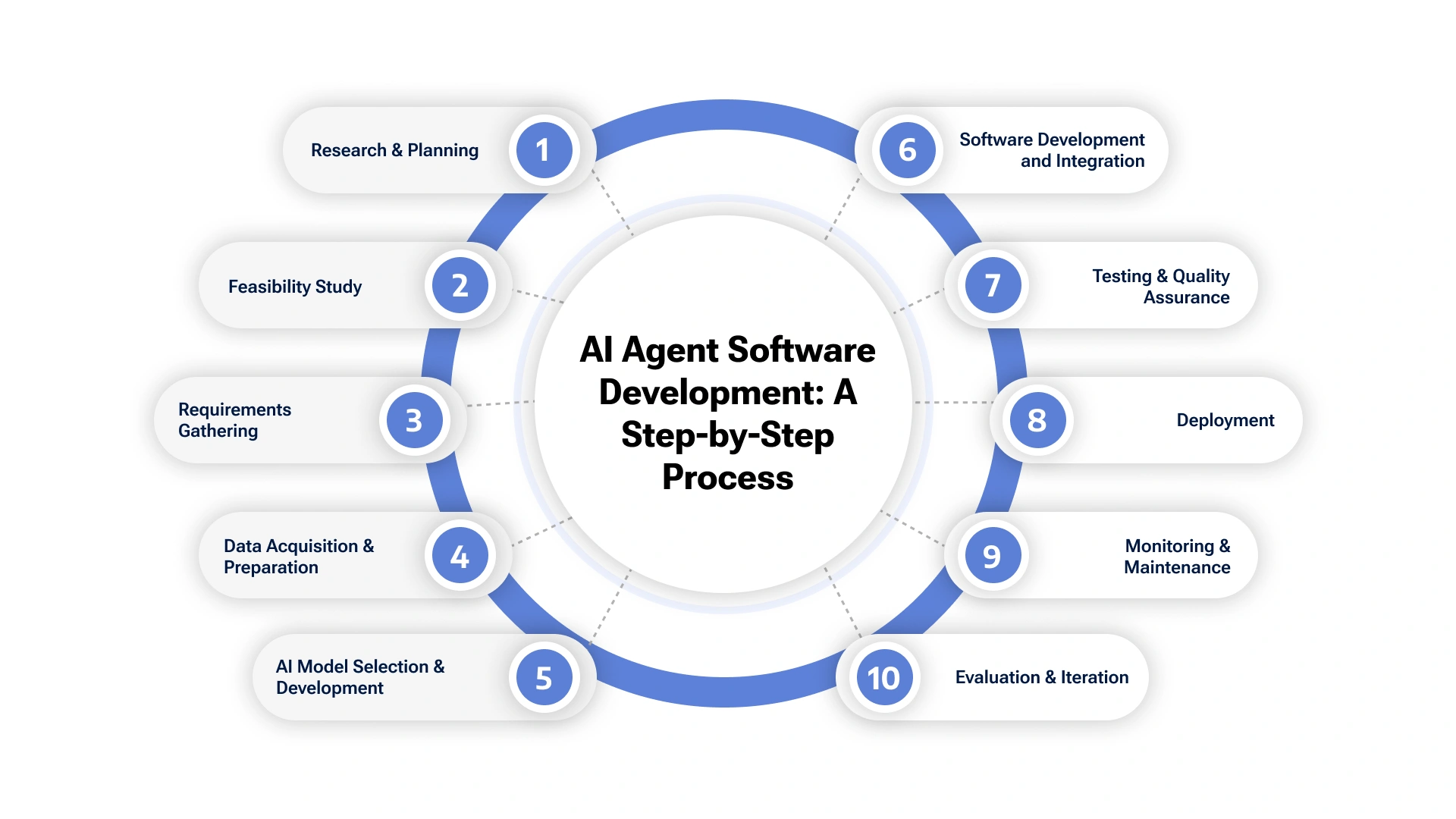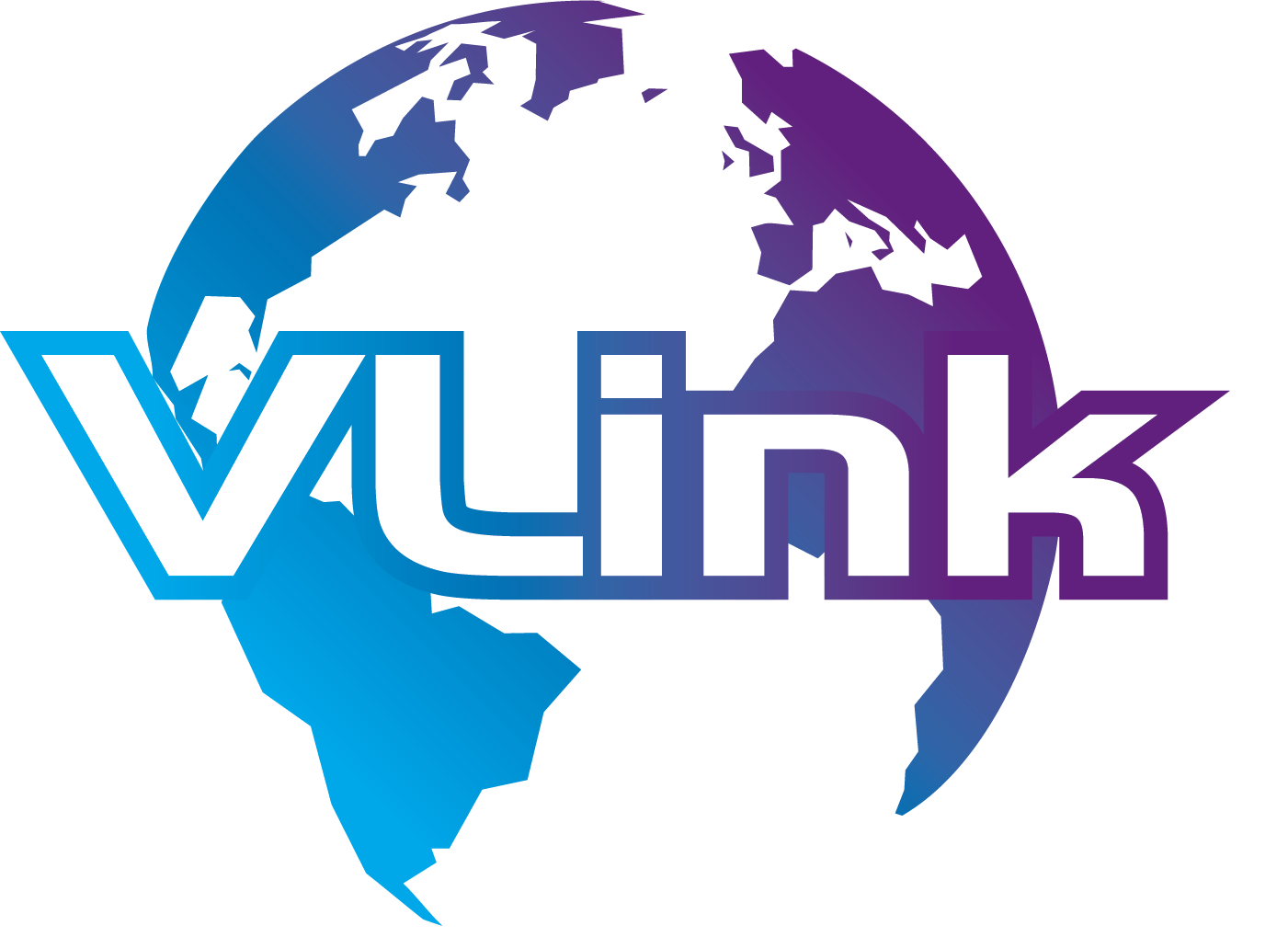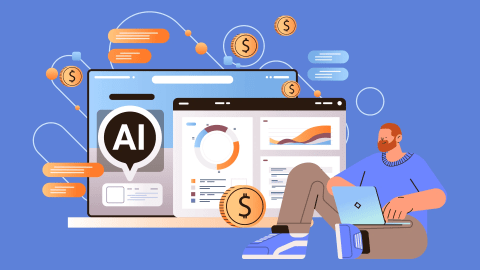Artificial intelligence (AI) is no longer a futuristic dream; it's a driving force, fundamentally reshaping industries and redefining how businesses operate. At the vanguard of this revolution are AI agents - intelligent software entities designed to perceive their environment, make informed decisions, and execute actions to achieve specific objectives.
From automating intricate customer service interactions to streamlining complex supply chain logistics, AI agents demonstrate remarkable capabilities in enhancing efficiency, elevating user experiences, and unlocking novel revenue streams.

This explosive growth is significantly fueled by the increasing role of foundational models in enhancing the intelligence and autonomy of AI agents. The integration of these advanced models empowers AI agents to autonomously perform intricate, multi-step tasks that were previously beyond the capabilities of traditional, rule-based bots. This dynamic landscape underscores AI agent software development's growing importance and potential.
However, for startup owners and CXOs contemplating the strategic integration of AI agents into their operational frameworks, a critical question invariably arises: How much does AI agent software development cost?
This inquiry does not yield a simple, uniform answer. The cost of developing AI agent software ranges from $30,000 to $300,000+. The financial outlay associated with creating an AI agent can vary considerably and be influenced by many factors, including the complexity of the agent, the specific industry of application, the geographical location of the development team, and the chosen technological infrastructure.
This comprehensive guide is meticulously crafted to demystify the cost intricacies of AI agent software development. We will embark on a detailed exploration of the fundamental nature of an AI agent, provide a structured overview of the associated development costs, analyze industry-specific cost variations, and dissect the crucial factors that influence the final price.
To truly understand the investment, let's first delve into the core question: What exactly is an AI agent, and why is it so crucial for modern businesses?
What Is an AI Agent and Why Does It Matter?
At its core, an AI agent is a sophisticated software program imbued with artificial intelligence capabilities that empower it to execute tasks with a significant degree of autonomy or semi-autonomy.
Unlike conventional software that rigidly adheres to pre-programmed instructions, an AI agent possesses the capacity to perceive its surrounding environment through various sensors (data inputs), process gathered information utilizing intricate AI algorithms (such as machine learning, natural language processing, and computer vision), make informed decisions based on this intelligent processing, and initiate actions through effectors (outputs or seamless integrations with other systems).
Conceptualize an AI agent as a knowledgeable digital assistant who can learn from experience, adapt to changing circumstances, and effectively solve problems within its designated domain.
These intelligent entities can span a broad spectrum of complexity, ranging from straightforward AI Chatbot applications designed to address basic customer inquiries to highly sophisticated systems capable of managing intricate logistical operations or analyzing vast and complex datasets to predict emerging market trends accurately.
But why do AI agents matter profoundly in today's rapidly evolving business landscape? Their increasing significance stems from their inherent potential to:
- Enhance Efficiency and Productivity: By automating repetitive and time-intensive tasks, AI agents liberate human employees to concentrate on more strategic, creative, and value-added endeavors. This fundamental shift leads to tangible increases in overall productivity and operational efficiency.
- Improve Customer Experience: AI-powered chatbots and virtual assistants can deliver instantaneous, personalized support to customers around the clock, seven days a week, fostering heightened customer satisfaction and unwavering loyalty.
- Drive Data-Driven Decisions: AI agents can analyze massive volumes of data faster and more efficiently than human analysts, extracting invaluable insights that can inform critical strategic decision-making processes and identify previously unseen growth opportunities.
- Reduce Operational Costs: The strategic implementation of automation through AI agents can yield significant reductions in labor costs, minimize the occurrence of human errors, and optimize the allocation of valuable resources.
- Gain a Competitive Advantage: By effectively harnessing the power of AI agents, organizations can offer innovative products and services, deliver highly personalized customer interactions, and respond with greater agility to dynamic market shifts, thereby securing a substantial competitive edge.
- Scale Operations Effectively: AI agents can seamlessly handle increasing workloads without necessitating proportional increases in human resources, enabling businesses to scale their operations with greater efficiency and cost-effectiveness.
- Enable Innovation: By automating routine tasks and providing insightful data analysis, AI agents empower human teams to dedicate their time and energy to fostering innovation and developing groundbreaking solutions.
The transformative potential of AI agents across diverse industries underscores the critical importance of businesses understanding the intricacies of their development costs as they strive to remain competitive and drive sustained future growth.
AI Agent Types and Classification
To accurately estimate development costs and understand capabilities, it's crucial to distinguish between various types of AI agents. AI agents are not monolithic; they operate with varying degrees of autonomy and intelligence.
We can broadly classify AI agents based on their complexity, autonomy, and the underlying technical architecture. Beyond the simple, mid-tier, and complex distinctions, here’s a deeper dive into agentic AI, co-pilots, and chatbots, along with their industry applications and technical capabilities:
- Chatbots: These are typically rule-based or powered by basic Natural Language Processing (NLP) models. They are designed for specific, predefined interactions and excel at handling frequently asked questions (FAQs) and simple conversational flows.
- Examples: Website FAQ chatbots, basic customer service bots for order status.
- Technical Capabilities: Rule-based logic, pattern matching, limited NLP for keyword recognition.
- Industry Application Example: A retail chatbot answering questions about store hours or return policies.
- Co-pilots (AI Assistants): More advanced than chatbots, co-pilots leverage sophisticated NLP and often Large Language Models (LLMs) to understand context, engage in more natural conversations, and assist users with a range of tasks. They augment human capabilities rather than entirely replacing them.
- Examples: Microsoft Copilot, GitHub Copilot, virtual assistants that schedule meetings or draft emails.
- Technical Capabilities: Advanced NLP (sentiment analysis, named entity recognition, contextual understanding), integration with multiple APIs, machine learning for personalized suggestions, often powered by LLMs like GPT-4o or Gemini.
- Industry Application Example: A marketing co-pilot assisting content creators by suggesting headlines, outlining articles, or summarizing research.
- Agentic AI (Autonomous Agents): These are the most sophisticated AI agents, designed to perceive, reason, plan, and act autonomously to achieve complex goals with minimal human intervention. They often involve multi-step reasoning, decision-making under uncertainty, and continuous learning. Agentic AI is a broader framework that enables AI agents to exhibit agency and pursue complex objectives.
- Examples: Autonomous vehicles, advanced fraud detection systems, AI agents managing complex supply chain logistics, AI for drug discovery.
- Technical Capabilities: Deep learning, reinforcement learning, computer vision, advanced NLP, multi-agent system coordination, real-time data processing, predictive analytics, goal-based reasoning, and adaptive learning.
- Industry Application Example: An autonomous financial trading agent executing trades based on real-time market analysis and predefined risk parameters.
Comparison of AI Agent Technical Capabilities:
| Feature/Capability | Chatbot | Co-pilot (AI Assistant) | Agentic AI (Autonomous Agent) |
| Autonomy Level | Low (rule-based or guided) | Moderate (augments human, often requires human oversight) | High (can act independently to achieve complex goals) |
| Core Technology | Rule-based systems, basic NLP | Advanced NLP, Machine Learning, and often LLMs | Deep Learning, Reinforcement Learning, Multi-agent Systems |
| Context Understanding | Limited (single-turn, keyword-based) | Good (multi-turn, conversational context) | Excellent (complex, dynamic, long-term context) |
| Task Complexity | Simple, predefined (FAQ, basic data retrieval) | Medium (drafting, scheduling, information synthesis) | High (multi-step planning, decision-making, adaptation) |
| Learning Capability | Minimal (pre-programmed) | Moderate (can learn from user interactions, fine-tuning) | High (continuous learning, adaptation to new data/environments) |
| Integration Needs | Basic (website, simple APIs) | Moderate (CRM, email, calendar APIs) | Extensive (ERP, IoT, custom enterprise systems, databases) |
| Data Requirements | Small, structured | Medium, can include unstructured text | Large, diverse, real-time, often unstructured data |
The nuances of each type significantly influence the development effort and the resulting cost. Businesses must carefully assess their specific needs to determine which type of AI agent will deliver the most value.
An Overview of Cost to Build an AI Agent Software
Accurately estimating the cost of developing AI agent software is not a standardized process with a single, universally applicable formula. However, we can provide a valuable general overview by categorizing projects based on their inherent complexity and then breaking down costs by development phase:
Project Complexity-Based Cost Overview:
Simple AI Agent Software:
- These typically encompass rule-based systems or basic AI-enabled Chatbot applications with limited natural language processing capabilities and a narrow scope of tasks. Their functionalities include simple data retrieval or the provision of predefined responses.
- Cost Range: $20,000 – $30,000+
- Timeline: 2 – 6 months
- Examples: Basic customer service AI Chatbot applications with frequently asked questions (FAQ) knowledge bases, simple automation scripts for routine data entry tasks.
Mid-Tier AI Agent Software:
- These more advanced AI agents possess enhanced capabilities, including sophisticated natural language understanding, the application of machine learning for basic prediction or classification tasks, and seamless integration with multiple software systems. They can handle more complex inquiries and learn from the data they process.
- Cost Range: $30,000 – $60,000+
- Timeline: 6 – 12 months
- Examples: Customer support AI Chatbot applications with sentiment analysis and personalized response generation, sales lead scoring systems, and basic fraud detection tools.
Complex AI Agent Software:
- These represent highly sophisticated systems that leverage cutting-edge AI techniques such as deep learning, computer vision, and intricate natural language processing. They can perform intricate and nuanced tasks, adapt dynamically to evolving environments, and often involve extensive data training and deep integration with multiple enterprise-level systems.
- Cost Range: $60,000 – $100,000+ (and potentially significantly higher)
- Timeline: 12+ months
- Examples: AI-powered virtual assistants exhibiting near-human conversational abilities, fully autonomous robots for manufacturing or logistics operations, advanced fraud detection and prevention systems, and AI applications for accelerating drug discovery processes.
AI Agent Development Cost Breakdown by Phase:
| AI Agent Development Phase | Estimated Cost Range (USD) | Percentage of Total Cost | What's Included |
| 1. Research & Planning | $5,000 – $15,000 | 5% – 10% | Defining problem, audience, goals, feasibility study, technology research, high-level architecture. |
| 2. Data Acquisition & Preparation | $10,000 – $70,000 | 10% – 25% | Data collection, cleaning, preprocessing, labeling, data augmentation for training, establishing data pipelines. This can be a significant cost driver, especially for specialized data. |
| 3. AI Model Development & Training | $15,000 – $100,000+ | 20% – 35% | Algorithm selection, model architecture design, initial model training, hyperparameter tuning, model validation. For complex deep learning models, compute costs for training can be substantial. |
| 4. Core Software Development (Backend & Frontend) | $10,000 – $80,000 | 15% – 25% | Developing the agent's core logic, API endpoints, database interactions, user interface (if applicable), and necessary backend services. |
| 5. Integration & API Development | $5,000 – $40,000 | 5% – 15% | Connecting the AI agent with existing CRMs, ERPs, databases, third-party APIs, and other enterprise systems. Custom API development for legacy systems can increase this cost. |
| 6. Testing & Quality Assurance | $5,000 – $30,000 | 5% – 10% | Unit testing, integration testing, performance testing, security testing, user acceptance testing, bias detection, and ethical AI validation. Specific AI testing methodologies are crucial here. |
| 7. Deployment & Infrastructure Setup | $2,000 – $15,000 | 2% – 5% | Setting up cloud or on-premise infrastructure, containerization (Docker, Kubernetes), CI/CD pipelines, initial scaling configurations. |
| 8. Project Management | $5,000 – $20,000 | 5% – 10% | Overseeing the entire development lifecycle, ensuring timely delivery, managing resources, and stakeholder communication. |
Note: It is crucial to recognize that these figures represent broad estimations. The actual cost can fluctuate substantially based on your project's specific requirements.
AI Agent Software Development Cost Across Different Industries
The specific industry in which the AI agent is intended for deployment can significantly influence the overall development cost. This variation arises due to differing data requirements, stringent regulatory landscapes, the inherent complexity of the tasks, and the necessity for specialized industry-specific expertise within the development team.
The following table outlines estimated cost ranges for AI agent development in various sectors:
AI Agent Development Cost by Industry (2025)
| Industry | Common AI Agent Functions | Estimated Cost Range (USD) |
| Healthcare | Symptom checkers, appointment bots, diagnostic assistants, drug discovery AI | $45,000 – $60,000+ |
| Education | Virtual tutors, learning assistants, personalized curriculum generators | $25,000 – $40,000+ |
| Finance | Budgeting bots, fraud detection, algorithmic trading agents, compliance checkers | $50,000 – $60,000+ |
| eCommerce | Customer service, product recommendations, inventory management | $30,000 – $50,000+ |
| Insurance | Claim bots, customer service, risk assessment | $35,000 – $55,000+ |
| Sports | Analytics agents, fan engagement bots, performance optimization | $30,000 – $50,000+ |
| Real Estate | Property matching, scheduling bots, market analysis | $30,000 – $45,000+ |
| Legal | Case analysis, document review bots, legal research assistants | $45,000 – $60,000+ |
| Human Resource | Resume screening, onboarding agents, employee support bots | $20,000 – $35,000+ |
As shown in the table, healthcare, finance, and legal industries often incur higher development costs due to stringent regulatory requirements, the need for high accuracy, and the sensitive nature of the data. In comparison, sectors like human resources may have lower average costs for simpler AI agents. Understanding your target industry's specific demands and inherent complexities is crucial for generating accurate and realistic cost estimations for your AI agent software development project.
Factors Influencing AI Agent Software Development Cost
A multitude of key factors contribute to the overall cost of developing AI agent software:

Complexity of the AI Model:
The level of sophistication of the AI algorithms required to power the agent's functionality is a primary driver of development cost. Simple rule-based systems are inherently less expensive to develop than those relying on advanced machine learning models (e.g., deep neural networks, reinforcement learning). Implementing advanced deep learning models necessitates significant specialized expertise, extensive datasets for training, and substantial computational resources. The more "intelligent" and autonomous the agent, the higher this cost component will be.
Data Requirements:
AI agents, particularly those leveraging machine learning, require access to large volumes of high-quality data for practical training. The expenses associated with data acquisition, meticulous data cleaning, accurate labeling, and secure data storage can be substantial. Generally, the more intricate the task the AI agent is designed to perform, the greater the volume and diversity of data typically required for its training. The cost of data labeling alone for complex models can be a significant hidden expense.
Feature Set and Functionality:
The sheer number and the inherent complexity of the features the AI agent needs to perform directly correlate with the overall development effort and associated cost. A basic AI Chatbot capable of handling simple question-and-answer interactions will incur a lower price than an AI agent that can understand nuanced natural language, seamlessly integrate with multiple disparate systems, execute intricate, multi-step tasks, and learn from its environment.
Integration Requirements:
Integrating the AI agent with existing software systems (such as CRM, Enterprise Resource Planning (ERP) systems, databases, and Application Programming Interfaces (APIs)) can introduce significant complexity and additional cost. This is particularly true if these legacy systems are outdated or require the development of custom integration solutions. Smooth data flow between the AI agent and your existing ecosystem is paramount for its effectiveness.
Technology Stack:
- The strategic selection of programming languages (e.g., Python, Java), AI frameworks (e.g., TensorFlow, PyTorch, Hugging Face), cloud platforms (e.g., AWS, Microsoft Azure, Google Cloud Platform), and other underlying technologies can directly influence the overall cost. Certain technologies necessitate specialized developer expertise or incur higher infrastructure-related expenses. The choice between proprietary solutions and open-source alternatives also impacts licensing and development costs.
Development Team:
The size, level of experience, and geographical location of the development team substantially impact the total cost. Engaging highly experienced AI specialists, data scientists, and proficient software engineers, particularly in regions with high labor costs such as the United States and Canada, will be more expensive than exploring outsourcing options to areas with more competitive labor rates.
- The hourly rates commanded by skilled developers can vary significantly based on their experience level and geographical location. In the US and Canada, senior AI developers can command hourly rates ranging from $150 to $300+ or even higher.
- In contrast, mid-level skilled developers might cost $100 to $200 per hour, and junior developers typically charge $50 to $100 per hour.
Team Structures:
- In-house: Offers maximum control and cultural alignment but comes with high overheads (salaries, benefits, infrastructure). Best for organizations with ongoing AI needs and a strong internal talent pipeline.
- Outsourcing: Can significantly reduce labor costs by leveraging talent pools in regions like India or Eastern Europe, where rates can range from $20-$80 per hour. However, it requires careful vendor selection, clear communication protocols, and robust quality control.
- Hybrid Models: A blend of in-house expertise for strategic oversight and outsourced teams for specific development tasks. This can balance cost-efficiency with control.
Key Roles and Salary Ranges (Annual, approximate, for US market):
- AI Engineer: $120,000 - $200,000+
- Data Scientist: $110,000 - $180,000+
- Machine Learning Engineer: $120,000 - $200,000+
- NLP Specialist: $110,000 - $190,000+
- DevOps Engineer (for MLOps): $100,000 - $170,000+
- Data Scientist: $110,000 - $180,000+
User Interface (UI) and User Experience (UX) Design:
- Suppose the AI agent is designed to interact directly with end-users (for example, an AI Chatbot or a virtual assistant). In that case, the meticulous UI/UX design of a user-friendly and intuitively navigable interface will contribute to the overall development cost. This is crucial for user adoption and satisfaction.
Testing and Quality Assurance:
- Rigorous and comprehensive testing is essential to ensure that the AI agent functions accurately, exhibits high levels of reliability, and consistently meets the defined performance expectations. This crucial phase encompasses unit testing, integration testing, and thorough user acceptance testing, all contributing to the overall project cost. Specific AI testing methodologies are particularly vital here.
Deployment and Infrastructure:
- The expenses associated with deploying and hosting the AI agent, including server infrastructure costs, cloud service utilization fees, and ongoing maintenance, must be carefully factored into the overall budget. Complex AI models might necessitate significant computational resources, further impacting infrastructure costs.
Ongoing Maintenance and Updates:
- AI models often require continuous monitoring of their performance, periodic retraining with newly acquired data, and regular software updates to maintain their accuracy, relevance, and adaptability to evolving environments. These ongoing costs are frequently underestimated but are crucial for the long-term success and effectiveness of the AI agent.
Hidden Costs of AI Agent Software Development
Beyond the readily apparent development expenses, several often-overlooked hidden costs can significantly impact the AI agent software development cost:
Expense for Data Cleaning and Labeling:
Before training AI models, raw data often requires extensive cleaning, meticulous preprocessing, and accurate labeling. This can be time-consuming and labor-intensive, particularly when dealing with large and intricate datasets. The data cleaning and labeling expense can be substantial and is often significantly underestimated in initial budget projections. This hidden cost can range from 10% to 25% of the total development budget, especially for projects requiring custom, annotated datasets.
Infrastructure Costs (Cloud Computing & Hardware):
Depending on the AI model's inherent complexity and the sheer volume of data it processes, infrastructure costs related to cloud computing services (e.g., AWS, Azure, Google Cloud Platform), secure data storage solutions, and specialized hardware (such as Graphics Processing Units—GPUs, or Tensor Processing Units—TPUs) can be considerable and recurring expenses. For advanced AI agents, these costs can range from $500 to $20,000+ per month, with specific components like LLM usage potentially costing $1,000-$5,000/month and retrieval infrastructure $500-$2,500/month. For high-performance training or inference, a single GPU can add thousands annually.
Integration Challenges:
Seamlessly integrating the AI agent with existing software systems might uncover unforeseen complexities and necessitate greater effort (and consequently, higher costs) than initially anticipated. Legacy systems often require custom adaptors, increasing this cost component.
Compliance and Regulatory Costs:
Industries operating under stringent regulatory frameworks (such as healthcare, finance, and legal) might incur additional costs to ensure that the AI agent fully complies with all relevant laws and industry-specific standards, including stringent data privacy (e.g., GDPR, HIPAA) and security requirements. This often involves legal consultations, audits, and specialized development to ensure adherence.
Talent Acquisition and Retention:
Hiring and successfully retaining highly skilled AI developers, experienced data scientists, and proficient engineers can be challenging and expensive, particularly given the high demand for these specialized professionals. Recruitment fees, competitive salaries, and benefits all contribute to this.
Model Drift and Retraining:
Over time, the performance of AI models can gradually degrade due to shifts in the underlying data or changes in the operational environment (a phenomenon known as model drift). Periodically retraining the AI model with fresh, relevant data is essential to maintain its accuracy and relevance, incurring additional operational costs. This ongoing expense, including prompt tuning (e.g., $1,000-$2,500/month) and monitoring (e.g., $200-$1,000/month), is crucial for long-term performance.
Security Costs:
Protecting the AI agent and the sensitive data it handles from potential cyber threats is crucial. This necessitates significant investment in comprehensive security measures (e.g., penetration testing, vulnerability assessments, security audits) and specialized security expertise (e.g., $500-$2,000/month for ongoing security measures).
Ethical Considerations and Bias Mitigation:
Ensuring that the AI agent operates ethically and without exhibiting harmful biases requires careful consideration during the design and development phases and thorough testing and validation, which can add to the overall development effort and associated cost. This includes dedicated resources for bias audits and fairness testing.
Maintaining a keen awareness of these potential hidden costs is essential for generating accurate budget forecasts and mitigating unexpected expenses during the AI agent development lifecycle.
ROI and Business Value Calculation
Demonstrating the return on investment (ROI) for AI agent development is crucial for securing budget and proving its value. Unlike traditional software, AI agents' ROI often involves both direct cost savings and indirect benefits like improved customer satisfaction and enhanced decision-making.
Framework for Calculating AI Agent ROI:
A comprehensive AI Agent ROI calculation should consider both quantitative and qualitative benefits. A general formula can be:
| ROI=Total Costs(Total Benefits (Monetary)−Total Costs)×100% |
Where:
- Total Benefits: Include quantifiable savings (e.g., reduced labor costs, error reduction, increased sales) and the monetary value of qualitative improvements (e.g., faster decision-making, improved customer loyalty).
- Total Costs: Encompass all development costs (initial investment, infrastructure, team salaries, etc.) and ongoing operational/maintenance costs.
Key Metrics to Track for ROI:
Cost Savings:
- Reduced Labor Costs: Hours saved by automating repetitive tasks (e.g., customer support inquiries handled by a chatbot vs. human agents).
- Error Rate Reduction: Decreased errors in processes (e.g., fraud detection, data entry).
- Optimized Resource Allocation: More efficient use of resources (e.g., supply chain optimization, energy management).
Revenue Generation:
- Increased Sales/Conversions: AI-powered recommendations, personalized marketing, or lead nurturing.
- New Revenue Streams: AI-driven products or services.
Productivity & Efficiency Gains:
- Time Savings: Time freed up for human employees to focus on strategic tasks.
- Faster Processing Times: Reduced time for data analysis, document processing, or decision cycles.
- Improved Throughput: Higher volume of tasks completed.
Customer Experience & Satisfaction:
- Reduced Response Times: Quicker resolution of customer queries.
- Personalization: Tailored interactions leading to higher engagement.
- NPS (Net Promoter Score) / CSAT (Customer Satisfaction Score) Improvement: Direct impact on customer perception.
Risk Mitigation:
- Reduced Fraud/Losses: AI for anomaly detection.
- Improved Compliance: Automated adherence to regulatory requirements.
Innovation & Competitive Advantage:
- While harder to quantify directly, faster innovation cycles and a stronger market position contribute significantly to long-term value.
Case Studies with Specific Financial Returns:
Sales Intelligence Agent (Inspired by Azilen's approach):
A B2B software company deployed an AI sales intelligence agent that automatically analyzes CRM data, identifies high-potential leads, and drafts personalized outreach emails. This agent saved the sales team approximately 150 hours per week, equating to a cost saving of $15,000 per week in human labor. This allowed sales representatives to focus on closing deals rather than prospecting, directly impacting revenue.
Automated Document Review for Legal Firm:
A legal firm implemented an AI agent to automate the review of thousands of legal documents for specific clauses and anomalies. This reduced the time spent on initial document review by 70%, freeing up paralegals and junior lawyers for more complex tasks. The firm estimated annual savings of over $250,000 in labor costs and significantly reduced the risk of human error in critical document analysis.
E-commerce Customer Service AI Chatbot:
A mid-sized e-commerce company integrated an AI chatbot with sentiment analysis. The chatbot handled 60% of common customer inquiries, reducing the need for human agents during peak hours. This led to a 25% reduction in customer service operational costs and a 10% increase in customer satisfaction due to faster response times and 24/7 availability.
By clearly outlining these metrics and providing concrete examples, businesses can build a compelling case for their AI agent investments.
Technical Infrastructure Requirements
The technical infrastructure forms the backbone of your AI agent, dictating its performance, scalability, and ultimately, its ongoing operational cost. Selecting the right technology stack and deployment environment is crucial.
Cloud Platforms: Most AI agent deployments leverage cloud computing for its scalability, flexibility, and managed services. The major players offer comprehensive AI/ML platforms:
AWS (Amazon Web Services):
- Pros: Most mature and comprehensive cloud provider with a vast array of AI/ML services (SageMaker, Rekognition, Comprehend, Lex). Offers high scalability and global reach—strong ecosystem for data storage and processing (S3, Redshift).
- Cons: Navigating the system can be complex, cost optimization requires expertise, and there is a deep learning curve.
Microsoft Azure:
- Pros: Strong integration with Microsoft enterprise products. Azure AI platform offers powerful services (Azure Machine Learning, Azure Cognitive Services). Good for hybrid cloud strategies.
- Cons: May not be as extensive as AWS in specific niche AI services.
Google Cloud Platform (GCP):
- Pros: Known for its strong AI/ML capabilities, especially in deep learning (TensorFlow, Vertex AI). Offers powerful data analytics services (BigQuery, Dataflow). Excellent for large-scale data processing and model training.
- Cons: Smaller market share compared to AWS, some services might be less mature.
Considerations:
- Cost: Cloud costs are usage-based; factor in compute (CPU/GPU), storage, data transfer (egress fees are crucial), and managed service fees.
- Scalability: Ensure the chosen platform can scale horizontally to handle increased user loads or data volumes.
- Security & Compliance: Evaluate the platform's security features and compliance certifications relevant to your industry.
- Integration: Assess how well the platform integrates with your existing IT infrastructure and third-party tools.
Hardware Requirements for Different Agent Complexities:
Simple AI Agents (e.g., Basic Chatbots):
- Hardware: Minimal. Can run on standard virtual machines (VMs) with basic CPU resources. No dedicated GPUs are typically required unless integrating with very light machine learning models.
- Storage: Moderate (for knowledge base, conversation logs).
Mid-Tier AI Agents (e.g., Co-pilots, basic ML models):
- Hardware: More robust VMs with higher CPU core counts and potentially some GPU acceleration if specific ML tasks (like basic inference for NLP) are performed frequently.
- Storage: Larger storage for training data, model artifacts, and operational data. Fast SSDs are recommended for better performance.
Complex AI Agents (e.g., Deep Learning, Computer Vision, Autonomous Systems):
- Hardware: High-performance computing (HPC) resources are essential. This means powerful GPUs (e.g., NVIDIA A100, H100) for training deep neural networks, large amounts of RAM (64GB to hundreds of GBs), and fast NVMe SSD storage for rapid data loading. For inference at scale, specialized AI accelerators (e.g., TPUs, custom ASICs) or optimized GPU instances might be used.
- Networking: High-bandwidth, low-latency network connections are critical for distributed training or real-time processing across multiple servers.
- Edge AI: For AI agents deployed directly on devices (e.g., smart cameras, industrial IoT), specialized, low-power hardware like FPGAs (Field-Programmable Gate Arrays) or custom AI chips designed for embedded systems are required.
Software Frameworks and Tools:
- AI/ML Frameworks: TensorFlow, PyTorch, scikit-learn (for traditional ML).
- NLP Libraries: Hugging Face Transformers, NLTK, spaCy.
- Containerization: Docker, Kubernetes (for managing and orchestrating containerized applications, especially important for scalable AI deployments).
- Version Control: Git.
- Monitoring Tools: Prometheus, Grafana, cloud-native monitoring services (e.g., AWS CloudWatch, Azure Monitor).
Integration Challenges with Existing Systems:
Integrating AI agents with legacy systems can be a significant technical hurdle. Older systems may lack modern APIs, requiring custom middleware or data connectors. Data formats can be inconsistent, necessitating extensive data mapping and transformation. Security protocols might also vary, requiring careful design to ensure secure data exchange. These challenges often add considerable time and cost to the development process.
The lifecycle of an AI agent extends far beyond its initial deployment. Ongoing maintenance is critical for its continued performance, accuracy, and relevance. These costs are frequently underestimated but are crucial for the long-term success and effectiveness of the AI agent.
Typical Annual Maintenance Costs:
As a general rule, you should budget for ongoing maintenance costs to be 15% to 30% of the initial development cost annually. This percentage can vary based on the agent's complexity, the frequency of data changes, and the need for new feature integrations.
Specific Cost Ranges for Maintenance Components (Monthly):
Beyond general percentages, here’s a granular breakdown of potential monthly costs for maintaining a sophisticated AI agent, inspired by industry benchmarks:
- LLM Usage: If your AI agent leverages large language models (LLMs) via APIs (like OpenAI's GPT models, Google's Gemini, Anthropic's Claude), costs are typically usage-based (per token or per API call).
- Estimated Cost: $1,000 – $5,000+ per month. This can fluctuate wildly based on the volume of interactions, the complexity of prompts, and the length of responses. High-traffic agents or those requiring extensive context windows will incur higher costs.
- Retrieval Infrastructure (RAG components): For agents using Retrieval Augmented Generation (RAG) to access and synthesize information from internal knowledge bases, there are costs associated with vector databases, search services, and data storage.
- Estimated Cost: $500 – $2,500 per month. This covers the indexing, storage, and querying of your proprietary data.
- Monitoring and Performance Tracking: Tools and human oversight are needed to monitor the agent's performance, identify model drift, track error rates, and ensure uptime.
- Estimated Cost: $200 – $1,000 per month. This includes cloud monitoring services, specialized AI observability platforms, and the time of MLOps engineers.
- Prompt Tuning and Optimization: AI agents, especially those powered by LLMs, require continuous prompt engineering and tuning to improve accuracy, reduce hallucinations, and adapt to new user queries or business requirements.
- Estimated Cost: $1,000 – $2,500 per month. This involves the time of AI specialists or prompt engineers.
- Security and Compliance Upkeep: Ongoing security monitoring, vulnerability patching, access control management, and ensuring continuous adherence to industry-specific regulations (e.g., HIPAA, GDPR, SOC 2).
- Estimated Cost: $500 – $2,000 per month. This includes security audits, vulnerability scanning tools, and the time of cybersecurity experts.
- Model Retraining: As mentioned, AI models can degrade over time (model drift) or become outdated with new data. Periodic retraining with fresh, relevant data is essential to maintain accuracy and relevance.
- Estimated Cost: Highly variable, but budget for $500 – $5,000+ per retraining cycle. Frequency depends on the application; some models may need weekly retraining, others quarterly or annually. This includes compute costs and data preparation.
- Software Updates & Bug Fixes: Standard software maintenance applies to AI agents too, covering bug fixes, security patches, and updates to underlying libraries or frameworks.
- Cloud Computing and Hosting Fees: Beyond specific LLM usage, general cloud infrastructure costs for compute, storage, and networking can add up significantly, especially for complex, data-intensive AI agents. For advanced implementations, these costs can easily reach $5,000 to $40,000 per year or more.
Factors Influencing Ongoing Costs:
- Volume of Usage: Higher user interaction or data processing volume directly translates to increased LLM usage, compute, and storage costs.
- Data Volatility: Industries with rapidly changing data (e.g., financial markets, social media trends) will require more frequent model retraining.
- Regulatory Changes: New compliance requirements can necessitate significant updates and re-audits.
- New Features/Enhancements: Adding new capabilities to the AI agent will incur additional development and integration costs.
- Team Expertise: Having an in-house MLOps or AI engineering team for ongoing maintenance can be more cost-effective in the long run than relying solely on external vendors.
These ongoing costs, while not part of the initial development outlay, are crucial for the long-term viability and effectiveness of your AI agent and must be meticulously factored into your operational budget.
How to Reduce AI Agent Development Costs
While the development of sophisticated AI agents can represent a significant financial investment, several strategic approaches can help optimize and potentially reduce overall costs:
- Clearly Define Scope and Objectives: A meticulously defined project scope with clearly articulated goals and specific deliverables can effectively prevent scope creep and the development of unnecessary features, thereby maintaining better control over project costs. Ambiguity in requirements is a significant cost accelerator.
- Start Small and Iterate with an MVP: Instead of attempting to build a fully comprehensive AI agent from the outset, consider adopting an agile approach by initially developing a Minimum Viable Product (MVP) encompassing core functionalities. Subsequent features can be iteratively added based on valuable user feedback and evolving business needs. This phased approach reduces initial investment and allows for course correction.
- Leverage Existing Tools and Platforms: Strategically utilize pre-built AI platforms, readily available libraries, and established cloud-based AI services to significantly reduce the need for extensive custom development of fundamental AI functionalities. Platforms such as AWS AI, Azure AI, and Google Cloud AI offer a wide array of services (e.g., pre-trained models for NLP, computer vision) that can accelerate the development process and potentially lower overall costs.
- Consider Open-Source Technologies: Explore utilizing open-source AI frameworks (e.g., TensorFlow, PyTorch), libraries (e.g., Hugging Face Transformers), and tools to substantially reduce or eliminate software licensing costs associated with proprietary solutions. This also often provides a large community for support.
- Optimize Data Collection and Preparation: Implement efficient and well-defined data collection strategies and invest in robust data cleaning and labeling processes early in the development cycle to minimize costly rework and later inefficiencies. Poor data quality is a significant driver of hidden costs and model underperformance. Consider using synthetic data for initial training if real data is scarce or expensive.
- Explore Outsourcing Options Carefully: While outsourcing development tasks can potentially reduce labor costs by leveraging talent pools in regions with lower hourly rates (e.g., India, Eastern Europe), it is crucial to thoroughly vet potential partners to ensure they meet your quality standards, maintain clear communication channels, and effectively align with your project goals. Consider nearshoring options as a balance between cost savings, improved time zone alignment, and cultural compatibility.
- Focus on ROI-driven Features: Prioritize the development of features and functionalities that offer the highest potential Return on Investment (ROI) and directly align with your key business objectives. Conducting a thorough ROI analysis of AI agent software development cost is essential for justifying the investment and ensuring its strategic alignment. Avoid "nice-to-have" features in early phases.
- Phased Deployment: Implement a phased deployment strategy, starting with a pilot program to gather valuable user feedback and identify any potential issues before undertaking a full-scale rollout across your organization. This iterative approach can help mitigate risks and optimize costs based on real-world usage.
- Effective Project Management: Implement robust project management methodologies and practices to ensure efficient resource allocation, timely completion of development tasks, and seamless communication within the entire development team. Strong project management minimizes delays and scope creep.
- Adopt Lightweight Architectures: Where feasible, opt for simpler, more efficient AI model architectures and deployment strategies that require fewer computational resources, reducing infrastructure costs.
- Implement Transfer Learning: Instead of training models from scratch, leverage pre-trained models and fine-tune them on your specific datasets. This significantly reduces training time and computational costs.
- Automate Hyperparameter Tuning: Utilize automated tools for hyperparameter optimization to minimize manual effort and time spent finding optimal model configurations.
Step-by-Step Process to Create AI Agent Software
While the specific steps involved in creating AI agent software may vary depending on the complexity and the intended application of the agent, a general and widely applicable process includes the following key stages:

1. Research and Planning:
Begin by clearly defining the specific problem you aim to solve with the AI agent, identifying the target audience for its application, and establishing well-defined goals and measurable success metrics for the project. Conduct thorough research into available AI technologies and potential software solutions that align with your objectives. This phase includes a comprehensive feasibility study to assess the technical viability, data availability and quality, and the potential Return on Investment (ROI) the AI agent is expected to deliver.
2. Feasibility Study:
Conduct a comprehensive assessment of the project's technical feasibility, the availability and quality of necessary data for training the AI model, and the potential Return on Investment (ROI) that the AI agent is expected to deliver. This phase also involves identifying potential risks and challenges and outlining strategies for mitigation to ensure a smoother development process.
3. Requirements Gathering:
Meticulously detail the AI agent's functionalities, desired features, and required performance characteristics. This crucial step involves clearly defining user interactions, the types of data inputs and outputs, and the necessary integration points with other existing systems. This is where detailed functional and non-functional requirements are documented.
4. Data Acquisition and Preparation:
Identify and gather all the necessary data to train the AI model. This critical stage encompasses data cleaning to remove inconsistencies and errors, preprocessing to transform the data into a suitable format, accurate labeling of the data for supervised learning, and potentially data augmentation techniques to increase the size and diversity of the training dataset. High-quality, relevant data is paramount for an effective AI agent.
5. AI Model Selection and Development:
Based on the project requirements and the characteristics of the prepared data, carefully select the most appropriate AI algorithms and frameworks (e.g., TensorFlow, PyTorch). Subsequently, the chosen AI model will be developed and rigorously trained using the prepared dataset. This involves iterating on model architectures, training cycles, and hyperparameter tuning to achieve optimal performance.
6. Software Development and Integration:
Develop all necessary software components to enable seamless integration of the trained AI model with other relevant systems (e.g., CRM, ERP, internal databases), and create a user interface (UI) if the AI agent is intended for direct user interaction. This includes building APIs, backend services, and a robust front-end for user interaction.
7. Testing and Quality Assurance:
Conduct rigorous and comprehensive testing procedures to ensure the AI agent functions accurately, consistently meets the defined performance benchmarks, and exhibits high reliability. This includes unit testing of individual components, integration testing of the interactions between different parts of the system, and thorough user acceptance testing to validate that the agent meets the needs of the end-users. As detailed previously, specific AI testing methodologies (e.g., prompt testing, bias testing, robustness testing) are critical here.
8. Deployment:
Deploy the thoroughly tested AI agent to the designated production environment. This might involve deploying to cloud infrastructure, installing an on-premise server, or seamless integration with existing software platforms. This phase includes setting up continuous integration/continuous delivery (CI/CD) pipelines for efficient updates.
9. Monitoring and Maintenance:
Continuously monitor the performance of the deployed AI agent, actively collect user feedback, and perform necessary ongoing maintenance, software updates, and periodic retraining of the AI model with new data to ensure optimal performance and to address any emerging issues or evolving requirements. This proactive approach helps prevent model degradation.
10. Evaluation and Iteration:
Regularly evaluate the AI agent's performance against the initially defined success metrics and iterate on its design and functionality based on the evaluation results and any evolving business needs or user feedback. This iterative cycle of development and improvement is fundamental to the success of AI systems.
Pricing Models for AI Agent Development: Choosing What Fits Best
Selecting the right pricing model is foundational for your AI agent software development journey. It directly impacts your budget predictability and the flexibility of the development process. Here's a more insightful look at standard models:
1. Fixed Price: Predictability for Defined Needs: The Fixed-Price model offers budget certainty, ideal for projects with clearly outlined AI agent requirements and a fixed scope. Basic AI chatbots, automation tools, or AI-driven workflow assistants typically cost between $20,000 and $50,000. This model prioritizes predictability but offers limited flexibility for incorporating new features beyond the initial agreement, potentially leading to additional costs for changes.
2. Time & Material: Flexibility for Evolving AI Projects: The Time & Material (T&M) model provides flexibility, charging based on the actual development time and resources utilized. With costs generally ranging from $30,000 to $60,000 for AI projects involving iterative development, such as machine learning-based recommendation engines or AI models requiring frequent optimizations, this approach allows for adaptation as the project evolves. However, the total cost can fluctuate depending on project complexity and changing requirements, necessitating careful monitoring.
3. Subscription-Based: Access Over Ownership: The Subscription-Based model offers access to pre-built AI-powered tools and platforms like SaaS chatbots, virtual assistants, or AI analytics platforms for a recurring monthly fee, typically ranging from $500 to $5,000+. This model provides a lower initial investment, making sophisticated AI accessible without a large upfront outlay. However, over the long term, the cumulative subscription expenses may exceed the cost of developing a custom AI agent tailored to your needs.
4. Revenue-Sharing: Aligning Development with Success: The Revenue-Sharing model presents an alternative with minimal upfront cost. Instead of traditional fees, the development partner receives a percentage (often 10-30%) of the revenue generated by the deployed AI agent. While this significantly lowers the initial financial barrier to entry, it's crucial to consider the long-term impact on your profitability, as a portion of your AI-driven product's revenue will be allocated to the developer. This model can be lovely for AI-powered SaaS platforms or AI tools integrated into subscription-based services.
Choosing the optimal pricing model requires careful consideration of your project's scope, budget constraints, desired flexibility, and long-term financial goals. Understanding the nuances of each model will empower you to make an informed decision that sets your AI agent development project up for success.
Real-World Examples of AI Agent Development
To provide concrete illustrations of the diverse applications and the potential range of development costs, here are a few real-world examples of AI agent development initiatives:
AI Chatbot for Customer Management:
A mid-sized e-commerce company successfully developed and implemented an AI-powered chatbot seamlessly integrated with its website and existing Customer Relationship Management (CRM) system. This AI agent was designed to handle common customer inquiries efficiently, provide real-time order tracking information, and offer basic customer support.
The total development cost for this AI chatbot for a customer management project was approximately $80,000, with ongoing maintenance and model retraining expenses estimated at around $5,000 per year. This strategic implementation resulted in a significant reduction in customer support response times and a noticeable improvement in overall customer satisfaction levels, leading to an estimated 20% reduction in customer service operational costs.
AI for Customer Engagement:
A large financial institution invested in developing an AI agent specifically designed to analyze extensive customer data and deliver highly personalized marketing messages and tailored product recommendations. The initial development cost for the AI for customer engagement project, which included complex data integration processes and extensive AI model training, was approximately $300,000+. This strategic investment yielded a demonstrable 15% increase in customer engagement metrics and improved customer conversion rates, leading to an estimated $1.5 million in additional revenue within the first year.
AI Chatbot Integration with Website:
A startup in the highly competitive travel industry integrated a basic AI chatbot into its company website to efficiently answer frequently asked questions about travel destinations and booking procedures. The total development cost for this relatively simple AI agent was approximately $15,000+. This implementation enabled the startup to handle a high volume of routine customer inquiries without requiring significant human intervention, improving efficiency and reducing reliance on manual customer support by 30%, saving roughly $10,000 annually in labor costs.
AI-Powered Predictive Maintenance in Manufacturing:
A prominent manufacturing company invested in a complex AI agent to analyze real-time sensor data collected from its critical machinery. The primary objective of this AI agent was to predict potential equipment failures and proactively schedule maintenance activities accurately. The total development cost for this sophisticated system exceeded $300,000, mainly due to the inherent complexity of the underlying AI model and the intricate integration requirements with existing industrial equipment. However, this significant investment resulted in substantial cost savings by preventing unexpected and costly downtime (reducing unplanned downtime by 25%) and significantly reducing overall maintenance expenses by 10%, leading to annual savings exceeding $500,000.
These real-world examples effectively highlight the wide range of applications for AI agents across various industries, the corresponding significant variations in development costs, and the potential for substantial business benefits.
Future of AI Agent Software Development
The dynamic field of AI agent software development is undergoing rapid and continuous evolution, driven by significant advancements in AI research, the increasing availability of powerful computational resources, and the ever-growing volume of accessible data.

Several key trends are poised to shape the future trajectory of this transformative technology:
- Advanced AI Models: We anticipate the emergence of even more advanced AI models characterized by significantly improved natural language understanding capabilities, enhanced reasoning abilities, and the capacity to handle increasingly complex and nuanced tasks. Recent developments in large language models such as Gemini AI and others will play a pivotal role in this evolution, enabling agents to perform more human-like conversations and complex problem-solving.
- Increased Accessibility and Democratization: AI development tools and platforms are becoming increasingly user-friendly and accessible to a broader range of developers and organizations, potentially lowering the entry barrier and overall development costs for specific AI agents. Low-code/no-code AI platforms will further democratize AI agent creation.
- Edge AI and On-Device Processing: The deployment of AI agents directly on edge devices (such as smartphones, drones, and various Internet of Things (IoT) devices) is expected to become more prevalent. This will enable real-time data processing with reduced latency, enhance privacy by keeping data local, and decrease reliance on centralized cloud infrastructure for latency-sensitive applications.
- Explainable AI (XAI): As AI agents become more deeply integrated into critical decision-making processes across various industries, the imperative for transparency and explainability will continue to grow. Explainable AI (XAI) techniques will empower users to understand the reasoning behind how AI agents arrive at their conclusions, fostering greater trust and accountability in their deployment, especially in regulated industries.
- Multi-Agent Systems: Developing increasingly sophisticated multi-agent systems, where multiple intelligent AI agents collaborate and coordinate to achieve a larger, shared objective, will become more common. This will enable complex workflows that individual agents cannot manage, leading to more robust and versatile AI solutions.
- Enhanced Human-AI Collaboration: The future will see a deeper integration of AI agents as "co-pilots" that work alongside humans, augmenting their capabilities rather than entirely replacing them. This collaboration will focus on leveraging the strengths of both AI (data processing, automation) and humans (creativity, critical thinking, empathy).
- Ethical AI and Governance: As AI agents become more powerful, the focus on ethical AI development, bias mitigation, and robust governance frameworks will intensify. Ensuring AI agents are fair, transparent, and accountable will be paramount.
Choose VLink for AI Agent Software Development
In the complex realm of AI agent software development, selecting the right partner is crucial for success. VLink offers expert AI development services, providing end-to-end solutions from initial planning to deployment and ongoing support. Our skilled team possesses deep knowledge of machine learning, natural language processing, and other key AI technologies, ensuring we can build sophisticated AI agents tailored to your business needs and objectives.
We prioritize understanding your unique challenges and goals, focusing on delivering AI agent software that provides tangible value and a strong ROI on AI agent software development costs. Our agile and collaborative approach ensures transparency and adaptability throughout the development process.
With experience across diverse industries and a commitment to quality and security, VLink is your trusted partner for navigating the intricacies of artificial intelligence development services. Don't wait to connect with our dedicated team for a personalized consultation and explore how our expertise can transform your business.
Wrap Up!
In conclusion, the cost of developing AI agent software is a variable equation, heavily influenced by complexity, data needs, industry specifics, and development choices. While simpler agents suit startup budgets, sophisticated enterprise solutions demand significant investment. For startup owners and CXOs, a deep understanding of cost drivers, hidden expenses, and optimization strategies is crucial. Defining scope, leveraging existing resources, and evaluating outsourcing are key to budget-conscious development.
Ultimately, the decision to invest in AI agents should be driven by a clear ROI and strategic value proposition. Despite the initial outlay, the long-term gains in efficiency, customer experience, data-driven insights, and competitive advantage position AI agent development as a vital, forward-looking investment for sustained business success in an increasingly AI-driven future.
Ready to explore how AI agents can transform your business? Contact our expert team today for a personalized consultation and a detailed cost estimation for your specific AI agent software development needs. We can help you navigate the complexities of AI development services and create a solution that aligns with your business goals and budget.










 Shivisha Patel
Shivisha Patel

















